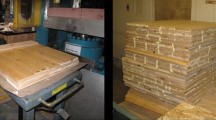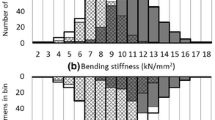Abstract
In the manufacturing process of cross-laminated timber (CLT), lumber selection and grading are essential steps for the quality control of CLT. In this work, a density-based lumber grading method was preliminarily evaluated for hem-fir CLT manufacturing. Based on the univariate regression model of hem-fir lumber modulus of elasticity (MOE) and its density, a density-based grading model was developed. To identify the effectiveness of the model, 470 pieces of thin hem-fir lumber, were segregated into four grades: E1, E2, E3, and E4 based on their density values. Two 3-ply thin-type customized CLT panels were also fabricated with E2 grade lumber as the parallel layer and E3 grade lumber as the transverse layer. Then, five CLT beam specimens were cut from each panel for flatwise bending test. Comparing the experimental and the theoretical values of the MOE, the relative errors were found to be + 11.95% (using shear analogy theory) and − 7.21% (using gamma theory), respectively. By comparison, for this hem-fir lumber, the accuracy of this density-based grading method is close to that obtained by other means of non-destructive testing. However, it seems to be simpler and more cost-effective for the potential hem-fir CLT manufacturing in some circumstances.






Similar content being viewed by others
References
ANSI/APA PRG 320 (2019) Standard for performance-rated cross-laminated timber. The Engineered Wood Association, APA, Tacoma
ASTM D198-15 (2015) Standard test methods of static tests of lumber in structural sizes. ASTM International, West Conshohocken
ASTM D6874-12 (2012) Standard test methods for nondestructive evaluation of wood-based flexural members using transverse vibration. ASTM International, West Conshohocken
Brandner R, Flatscher G, Ringhofer A, Schickhofer G, Thiel A (2016) Cross laminated timber (CLT): overview and development. Eur J Wood Prod 74:331–351
Brashaw BK, Vatalaro RJ, Wacker JP, Ross RJ (2005) Condition assessment of timber bridges. 1. Evaluation of a micro-drilling resistance tool. Forest Products Lab, Madison
Brown LS, DeVisser DA, Tuvey R, Rozek A (1997) Mechanically graded lumber: the grading agency perspective. Wood Design Focus 8:3–7
Burdon R, Britton R, Walford G (2001) Wood stiffness and bending strength in relation to density in four native provenances of Pinus radiata. Nz J Forestry Sci 31:130–146
Downes GM, Nyakuengama JG, Evans R, Northway R, Blakemore P, Dickson RL, Lausberg M (2002) Relationship between wood density, microfibril angle and stiffness in thinned and fertilized Pinus radiata. Iawa J 23:253–265
Gagnon S, Pirvu C (2011) CLT handbook: cross-laminated timber. FPInnovations, Canada
GB/T 28993-2012 (2012) Standard test methods for mechanical properties of structural lumber. Standards Press of China, Beijing
Gong M, Li L, Chui YH (2019a) Evaluation of bond strength of cross-laminated LSL specimens under short-span bending. Holzforschung 73:789–795
Gong YC, Liu FL, Tian ZP, Wu GH, Ren HQ, Guan C (2019b) Evaluation of mechanical properties of cross-laminated timber with different lay-ups using Japanese larch. J Renew Mater 7:941–956
Guller B (2007) The effects of thinning treatments on density, MOE, MOR and maximum crushing strength of Pinus brutia Ten wood. Ann Forest Sci 64:467–475
Hanhijarvi A, Ranta-Maunus A, Turk G (2005) Potential of strength grading of timber with combined measurement techniques. Vtt Publications 568
He MJ, Sun XF, Li Z (2018) Bending and compressive properties of cross-laminated timber (CLT) panels made from Canadian hemlock. Constr Build Mater 185:175–183
Jiang JH, Lu JX, Ren HQ, Long C (2010) Predicting the flexural properties of Chinese fir (Cunninghamia lanceolata) plantation dimension lumber from growth ring width. J Wood Sci 56:15–18
Lachenbruch B, Johnson G, Downes G, Evans R (2010) Relationships of density, microfibril angle, and sound velocity with stiffness and strength in mature wood of Douglas-fir. Can J Forest Res 40:55–64
Li H, Wang BJ, Wei PX, Wang LB (2019) Cross-laminated timber (CLT) in China: a state-of-the-art. J Biores Bioprod 4:22–30
Liao YC, Tu DY, Zhou JH, Zhou HB, Yun H, Gu J, Hu CS (2017) Feasibility of manufacturing cross-laminated timber using fast-grown small diameter eucalyptus lumbers. Constr Build Mater 132:508–515
Machado JS, Louzada JL, Santos AJA et al (2014) Variation of wood density and mechanical properties of blackwood (Acacia melanoxylon R. Br.). Mater Design (1980–2015) 56:975–980
Mamdy C, Rozenberg P, Franc A, Launay J, Schermann N, Bastien JC (1999) Genetic control of stiffness of standing Douglas fir; from the standing stem to the standardised wood sample, relationships between modulus of elasticity and wood density parameters. Part I. Ann Forest Sci 56:133–143
Missanjo E, Matsumura J (2016) Wood density and mechanical properties of Pinus kesiya Royle ex Gordon in Malawi. Forests 7:7–135
NLGA (2014) Standard grading rules for canadian lumber. National Lumber Grades Authority, Surrey, p 2014
Oja J, Grundberg S, Grönlund A (2007) Predicting the strength of sawn products by X-ray scanning of logs: a preliminary study. Wood Fiber Sci 32:203–208
Panshin AJ, De Zeeuw C (1964) Textbook of wood technology. McGraw-Hill, New York
Rozenberg P, Franc A, Mamdy C, Launay J, Schermann N, Bastien JC (1999) Genetic control of stiffness of standing Douglas fir; from the standing stem to the standardised wood sample, relationships between modulus of elasticity and wood density parameters. Part II. Ann Forest Sci 56:145–154
Sandoz J (1989) Grading of construction timeber by ultrasound. Wood Sci Technol 23:95–108
Sikora KS, McPolin DO, Harte AM (2016) Effects of the thickness of cross-laminated timber (CLT) panels made from Irish Sitka spruce on mechanical performance in bending and shear. Constr Build Mater 116:141–150
Wang BJ, Dai CP, Middleton G (2010a) Manufacturing and performance evaluation of LVL made from stress graded hem-fir veneer Report for BC Coastal Forest Sector Hemfir Initiative. Department of Engineered Wood Products, FPInnovations, Vancouver
Wang BJ, Dai CP, Middleton G, Munro D (2010b) Characterizing short-rotation coastal hemlock and amabilis fir veneer properties: preliminary results Report to Coastal Forest Sector Hem-fir Initiative. Department of Engineered Wood Products, FPInnovations, Vancouver
Wang BJ, Dai CP (2013) Development of structural laminated veneer lumber from stress graded short-rotation hem-fir veneer. Constr Build Mater 47:902–909
Wang BJ, Zhang H, Wu L, Huang S, Lu J, Zidek J (2013) Property modeling of Changbai Larch (Larix Olgensis Henry) veneers in relation to stand and tree variables. Wood Fiber Sci 3:314–329
Wang ZH, Wang Z, Wang BJ, Wang YL, Liu B, Rao X, Wei PX, Yang Y (2014) Dynamic testing and evaluation of modulus of elasticity (MOE) of SPF dimensional lumber. BioResources 9:3869–3882
Wang BJ, Wei PX, Gao ZZ, Dai CP (2018) The evaluation of panel bond quality and durability of hem-fir cross-laminated timber (CLT). Eur J Wood Prod 76:833–841
Watt MS, Sorensson C, Cown DJ, Dungey HS, Evans R, Evans R (2010) Determining the main and interactive effect of age and clone on wood density, microfibril angle, and modulus of elasticity for Pinus radiata. Can J Forest Res 40:1550–1557
Wei PX, Wang BJ, Li H, Wang L, Peng S, Zhang L (2019a) A comparative study of compression behaviors of cross-laminated timber and glued-laminated timber columns. Constr Build Mater 222:86–95
Wei PX, Wang BJ, Wan X, Chen X (2019b) Modeling and prediction of modulus of elasticity of laminated veneer lumber based on laminated plate theory. Constr Build Mater 196:437–442
Xie WB, Lu Y, Wang Z, Wang XW, Wu XL, Gao ZZ (2019) Feasibility of predictive assessment of bending performance of CLT plates of Canadian hemlock. BioResources 14:6047–6059
Yang J, Evans R (2003) Prediction of MOE of eucalypt wood from microfibril angle and density. Holz Roh Werkst 61:449–452
Zhou JH, Chui YH, Gong M, Hu L (2017) Elastic properties of full-size mass timber panels: Characterization using modal testing and comparison with model predictions. Compos Part B Eng 112:203–212
Acknowledgements
This work was supported by Alberta/Zhejiang International Technology Partnership (ITP) Program, Enterprise Practical Training Program for Young Teachers in Higher Vocational Colleges of Jiangsu province (2019QYSJ071), National First-class Disciplines (PNFD), and Priority Academic Program Development of Jiangsu Higher Education Insitutions (PAPD).
Author information
Authors and Affiliations
Corresponding authors
Additional information
Publisher's Note
Springer Nature remains neutral with regard to jurisdictional claims in published maps and institutional affiliations.
Rights and permissions
About this article
Cite this article
Li, H., Wang, L., Wang, B.J. et al. Preliminary evaluation of a density-based lumber grading method for hem-fir CLT manufacturing. Eur. J. Wood Prod. 79, 967–975 (2021). https://doi.org/10.1007/s00107-020-01653-3
Received:
Accepted:
Published:
Issue Date:
DOI: https://doi.org/10.1007/s00107-020-01653-3




